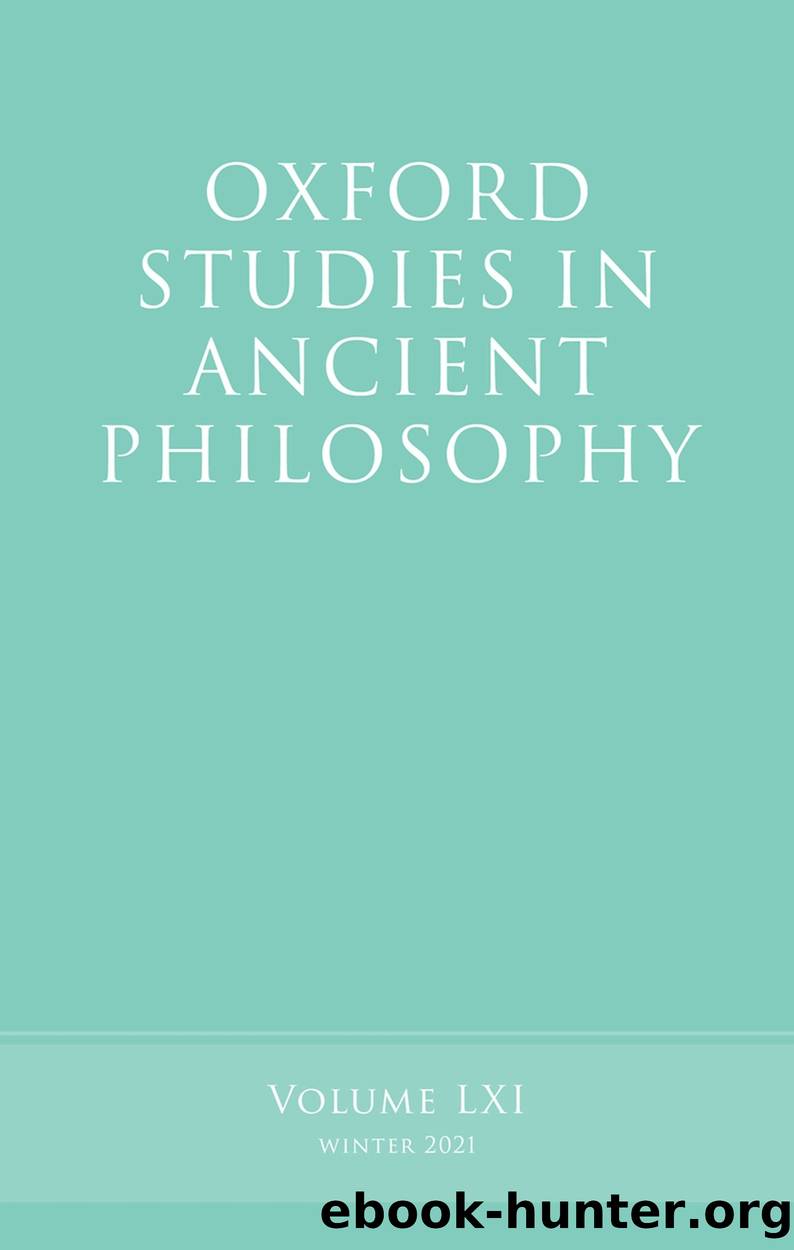Oxford Studies in Ancient Philosophy, Volume 61 by Victor Caston;

Author:Victor Caston; [Caston, Victor]
Language: eng
Format: epub
ISBN: 9780192688354
Publisher: Oxford University Press USA
Published: 2022-08-02T00:00:00+00:00
6. Problems for the parts interpretation
6.1. Weakness of motivations
As we have seen, the parts interpretationâs principal motivation is the tension between (i) Aristotleâs supposed rejection of Inherent Properties and commitment to Imprecision in Metaphysics Î. 2 and (ii) his claims elsewhere that geometrical objects belong somehow to the sensible realm.
But as with most of the aporiai Aristotle raises, his Book Î treatment simply describes the difficulty as it currently stands and problematizes certain positions but does not yet develop a solution. Thus, Î. 2 taken on its own will not allow us to determine whether Aristotle really (i) rejects Inherent Properties and endorses Imprecision.100 It must rather be taken together with Aristotleâs resolution of this part of the fifth aporiaâa resolution we do not come to until Metaphysics Î. 3. And when we consider Î. 2 and Î. 3 together, the supposed tension motivating the parts interpretation disappears.
In Î. 3, Aristotle resolves the aporia by employing a familiar strategy: he introduces a distinction that allows him to accept a qualified version of one claim (Imprecision) that is compatible with the other (Inherent Properties). In this case he distinguishes between sensible magnitudes qua sensible (ᾠαἰÏθηÏά) and sensible magnitudes just insofar as they have a certain quality or attribute (μὴ ᾠαἰÏθηÏá½° á¼Î»Î»â á¾ Ïοιαδί, 1077b20â2)âas we have seen in Section 3.3. Further, he claims that there can be propositions and demonstrations (λÏγοι καὶ á¼ÏοδείξειÏ) that are still about sensible magnitudes (ÏεÏὶ Ïῶν αἰÏθηÏῶν μεγεθῶν) even when they are about them not as sensible.101 This distinction allows him to resolve the aporia by limiting the scope of Imprecision: insofar as they are sensible, sensible objects (and specifically sensible magnitudes) are imprecise and so cannot be what mathematical statements are about; but insofar as they have (that is, really have) mathematical properties, certain sensible objects are adequate to the task. That is, Aristotle distinguishes between:
Thoroughgoing Imprecision: Sensible objects are imprecise, while geometrical statements and theorems are about perfectly precise objects; hence, sensible things cannot be the objects of geometry in any respect.
Sensible Imprecision: Sensible objects qua sensible are imprecise, while geometrical statements and theorems are about perfectly precise objects; hence, sensible things qua sensible cannot be the objects of geometry.
Aristotle rejects Thoroughgoing Imprecision but accepts Sensible Imprecision: while sensible objects fail to be perfectly precise qua sensible,102 in a different respectâqua quantitative and continuous, but not qua sensibleâcertain sensibles are parent subjects for kooky objects that are precise and so adequate.
But this immediately raises a new question: which sensible objectsâeven not qua sensibleâcould possibly be adequate to the task? Since Aristotle aims to explain how it is that geometers speak rightly (Î. 3, 1078a29), and geometers often make statements about the precise construction drawings they produce in the course of their research, it would have been natural for him to identify these construction drawings as the special sensible objects of the geometer. This is especially likely given that Aristotle would have directly observed the strong practical, banausic element of geometrical practice.103 If
Download
This site does not store any files on its server. We only index and link to content provided by other sites. Please contact the content providers to delete copyright contents if any and email us, we'll remove relevant links or contents immediately.
Phoenicians among Others: Why Migrants Mattered in the Ancient Mediterranean by Denise Demetriou(575)
Verus Israel: Study of the Relations Between Christians and Jews in the Roman Empire, AD 135-425 by Marcel Simon(575)
Caesar Rules: The Emperor in the Changing Roman World (c. 50 BC â AD 565) by Olivier Hekster(557)
Europe, Strategy and Armed Forces by Sven Biscop Jo Coelmont(504)
american english file 1 student book 3rd edition by Unknown(474)
Give Me Liberty, Seventh Edition by Foner Eric & DuVal Kathleen & McGirr Lisa(469)
Banned in the U.S.A. : A Reference Guide to Book Censorship in Schools and Public Libraries by Herbert N. Foerstel(467)
The Roman World 44 BC-AD 180 by Martin Goodman(457)
Reading Colonial Japan by Mason Michele;Lee Helen;(457)
Basic japanese A grammar and workbook by Unknown(453)
DS001-THE MAN OF BRONZE by J.R.A(442)
The Dangerous Life and Ideas of Diogenes the Cynic by Jean-Manuel Roubineau(437)
Introducing Christian Ethics by Samuel Wells and Ben Quash with Rebekah Eklund(433)
Imperial Rome AD 193 - 284 by Ando Clifford(431)
The Oxford History of World War II by Richard Overy(431)
Literary Mathematics by Michael Gavin;(392)
Language Hacking Mandarin by Benny Lewis & Dr. Licheng Gu(379)
Catiline by Henrik Ibsen--Delphi Classics (Illustrated) by Henrik Ibsen(367)
How to Reach the 9.0 in IELTS Academic Reading by IELTS Medical(357)
